
Next month “Witchfinder” is coming back. Boy, does it make me happy to say that. The new five-issue miniseries, ‘The Gates of Heaven,’ is written by Chris Roberson and Mike Mignola with art by D’Israeli, and today we’re chatting with Roberson about it.

trade collection
Chris Roberson: As I’ve said many times before, Sir Edward is my favorite character in the world of Hellboy, and Witchfinder was the first project that I had an opportunity to pitch. There was actually an earlier idea that was quickly shelved, that took place much later in Sir Edward’s career (and which we will probably get around to doing when we catch up to that point in the timeline), but when Mike and Scott Allie explained that they were more interested in handling Sir Edward’s adventures in a more chronological order, I pretty quickly hit upon the idea of digging into that cryptic reference in ‘Wake the Devil,’ and connecting it with what we knew about the vampires’ long-term plans from ‘The Pickens County Horror.’
But definitely, with the different writers for each of the previous arcs, the tone and structure of “Witchfinder” had continually shifted a bit, and I wanted to pull characters and settings from each of them as much as possible so we could establish what Sir Edward’s status quo was at this stage of his career. Using the St. John of the Cross Police Hospital as a kind of home base, beefing up the roles of Mr. Silk, Doctors Lewis and Manley, and Miss Goad, and bringing back Augustus Swain and the Heliopic Brotherhood was both an attempt to connect the story we were telling with what had come before, but also to give Sir Edward someone to talk to (or yell at, as the case may be). I lucked out in a lot of ways, too. When I first suggested including Tefnut Trionis in the story, the character had only appeared in a brief mention in the Hellboy Companion, and it wasn’t until Mike sent me his scripts for “Frankenstein Underground” that I learned that she played a part in that, as well. And the fact that Ben was already drawing the character there helped to connect what we were doing in ‘City of the Dead’ to the rest of the Hellboy Universe even more.
But in terms of making the character my own, I guess the biggest change that we made here was to incorporate the narrative captions. I’m always wary of using narrative captions in general, and in the Hellboy Universe in particular, and always prefer to let the art and dialogue carry the story along whenever possible. But we knew from “Abe Sapien: The Drowning” that Sir Edward kept secret journals, and I figured that would be a handy way to establish a voice for the series, and also to cover ground a bit more quickly in some of the investigation scenes.
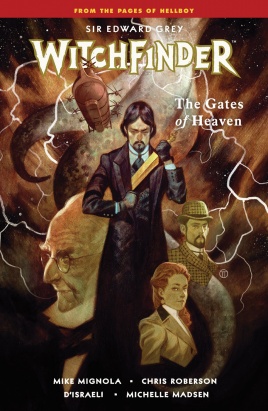
future trade collection (2019)
Chris: Way back on page one of the first issue of ‘Seed of Destruction’ we got the first mention of the British Paranormal Society, but aside from that one scene with Professor Bruttenholm and Lady Cynthia Eden-Jones, we’ve haven’t ever really seen much of the group in action. According to the Hellboy Companion the Society was founded by a group of Oxford researchers in 1877 “to investigate psychic and paranormal phenomenon [sic] using scientific methods,” so it seemed to me that it was likely that they would have crossed paths with Sir Edward at some point along the line.
Continued belowIn addition to independent researchers like the British Paranormal Society, in ‘The Gates of Heaven’ we learn that Sir Edward isn’t the only person looking into the unusual and unexplained for Queen Victoria. British soldiers and explorers keep finding odd artifacts and ancient technologies left behind by lost civilizations, and a lot of them end up in the hands of an organization called the Foundry. To say too much about them might run the risk of spoiling things, but I will say that not everyone who gets their hands on an ancient artifact would necessarily be interested in the paranormal or supernatural; an engineer might be more interested in how the thing was made, and whether its design could be adapted to make a more efficient engine, or a more powerful battleship.
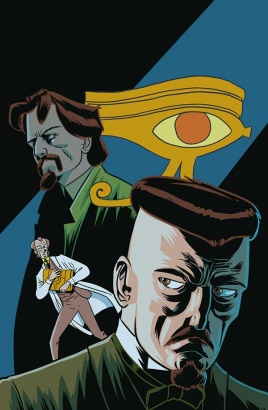
Chris: Between the Heliopic Brotherhood, the British Paranormal Society, and the Foundry, the stage is already pretty crowded in ‘The Gates of Heaven.’ But that’s not to say that the influence of other secret societies won’t be felt, or that we won’t be touching on things that longtime readers might associate with other groups that we have seen before.
In addition to the new characters joining “Witchfinder,” you’ve also got a new artist. As I understand it, you’re quite excited about this. What is it about D’Israeli that draws you to his work and what do you think he brings to “Witchfinder”?
Chris: I’ve been a huge fan of D’Israeli’s since I first saw his work in the pages of Deadline magazine almost thirty years ago, and I particularly love the things that he’s done set in the Victorian era, like “Scarlet Traces” and “Leviathan” (both with Ian Edginton). When Mike and I first started talking about the idea that eventually evolved into ‘The Gates of Heaven,’ we knew that there was going to be a kind of steampunk aspect to the technology that features in the plot. And so when Mike asked who I had in mind to handle the art duties, D’Israeli’s was the first name that I suggested, because I couldn’t think of another artist better suited to capture both the Victorian setting and that kind of steampunk vibe. Thankfully, Mike agreed, and D’Israeli was willing to take it on, and here we are. And having seen the art for the first few issues, I’m delighted to say that I was right, because they look amazing!
They certainly do. D’Israeli brings a new look to the series too, and I don’t just mean his drawing style. His black gutters give the comic a differing feeling, and Clem Robins is using a new lettering style. I’m curious what drove these changes.
Chris: There weren’t any specific calls about the gutters in the script, so that might have been something that D’Israeli decided on his own or after discussion with our editor Katii O’Brien. (He’s used a similar approach in other projects like “Stickleback” before, so it might just have been his preference.) And the same goes for the lettering. You’d have to ask Clem and Katii!
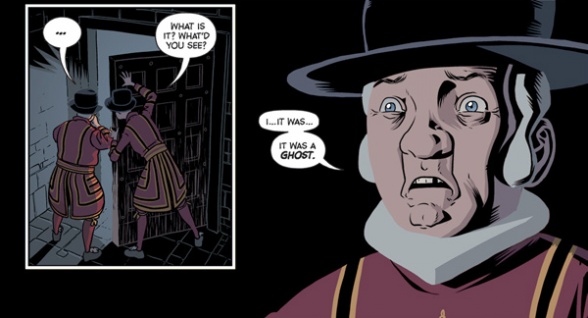
But I think in general, as we move ahead that the sense of what a “Witchfinder” series should look and feel like it constantly evolving, and continually coming into greater focus. There was a lot of back and forth about what the title for this new arc would be, and we went through a number of different iterations until we hit upon ‘The Gates of Heaven,’ at which point I think we collectively realized that titles that follow the format ‘[The] Something of [the] Something’ just sound like Witchfinder titles, and that when we stray away from that it doesn’t seem to fit as well.
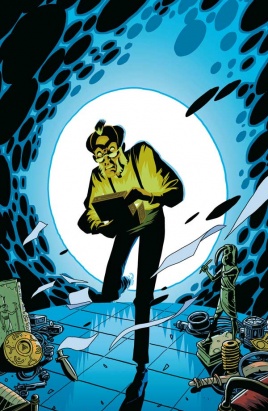
Chris: To a certain extent, yes. But just as freeing, I think, is the fact that there tends to be a lot more blank space on the canvas in that era, as it were. With the stuff that’s set in the mid-20th century to modern day, there are existing stories and established bits of characters’ backstories in just about every year, and so when telling a new story it’s necessary to thread our way through that stuff so as not to contradict anything that’s come before. But aside from a few significant dates, Sir Edward’s career is much more wide open, so we have the flexibility of doing all sorts of different kinds of stories…
Coming May 23, 2018…
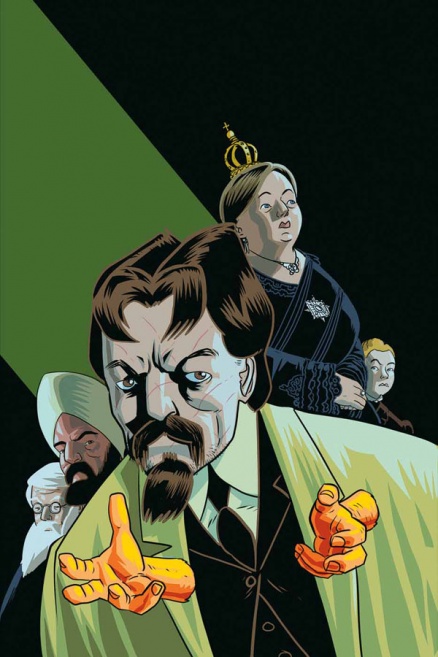
Written by Mike Mignola and Chris Roberson
Illustrated by D’Israeli
Colored by Michelle Madsen
Lettered by Clem RobinsA series of occult events mystifies the man known as the Witchfinder, but even more surprising is the revelation that he is not alone in exploring the paranormal in London. When a personal invitation arrives from the palace, Sir Edward Grey is pulled even deeper into underground supernatural exploration alongside new allies in the race to stop a mad scientist from destroying London in his pursuit of mystical power.
“Though the works and mythos of Mike Mignola are vast and complex, the Witchfinder franchise succeeds due to its accessibility.” —Newsarama






